So what is the light bulb ban?
In September 2018, the final stage of an EU directive banning the import or manufacture of incandescent light bulbs took effect. This directive was introduced by the European Commission in 2009 to restrict the sale of ‘high-energy’ light bulbs, in favour of alternative energy-saving technologies, such as LED or ultra-efficient LED. The European Commission, UK Government and other national authorities are all aligned in their drive to tackle climate change and create a better environment for the future.
The ban has been enforced against almost all types of incandescent light bulbs, using either traditional or halogen technologies and the legislation has recently been expanded to include a phase out of compact fluorescent (CFL) light bulbs.
The EU regulations also cover fluorescent tubes and are designed to stop the manufacture of the least efficient, lowest performance tubes in favour of higher-performing products.
There is also a RoHS Mercury directive which has been recently reviewed and will come into effect during 2023 which will impose restrictions relating to lamps for general lighting that contain mercury.
From the date that either legislations comes into effect, the relevant light bulbs are banned in the UK from import and cannot be placed on the market, though stock already held in the UK can be sold through.
Time-line of the light bulb ban:
1st September 2009
- Clear Incandescent light bulbs of 100W and above
- Non-clear (frosted or pearl) 100W lamps must have an energy rating of A or better
- 100W and above equivalent LED light bulbs are available
1st September 2010
- Clear Incandescent light bulbs of 75W and above
- 60 W class D and E (≥ 725 lm) Halogen bulbs
- Non-clear (frosted or pearl) 75W lamps must have an energy rating of A or better
- 75W equivalent LED light bulbs are available
1st April 2010
- Standard Halophosphate tubes, can no longer be manufactured or imported into the EU. In the vast majority of cases, these can be replaced by the equivalent Triphosphor tube. The Triphosphor tubes are longer life, higher efficiency and improved colour rendering compared to their Halophosphate versions. LED replacements of most Fluorescent tubes are also now widely available.
1st September 2011
- Clear Incandescent light bulbs of 60W and above
- 40 W class D and E (≥ 450 lm) Halogen bulbs
- Non-clear (frosted or pearl) 60W lamps must have an energy rating of A or better
- 60W equivalent LED light bulbs are available
1st April 2012
- Fluorescent T12 (38mm diameter) tubes are withdrawn. These are inefficient compared with their T8 (26mm) or T5 (16mm) counterparts. Most T12 tubes can simply be replaced by their equivalent length fluorescent T8 tube
1st September 2012
- Clear Incandescent light bulbs of 40W and above
- 25 W class D and E (≥ 60 lm) Halogen bulbs
- Non-clear (frosted or pearl) 40W lamps must have an energy rating of A or better
- 40W equivalent LED light bulbs are available
1st September 2013:
- Bulbs capped S14, S15 and S19
1st February 2016
- Amendments to the original directive were introduced, more clearly defining ‘rough service’ and ‘special purpose’ light bulbs. This closed a loophole that allowed retailers to continue to make incandescent light bulbs that would otherwise have been covered by the ban.
1st September 2016
- Directional Halogen lamps (such as halogen PAR and halogen GU10 spotlights)
- LED replacement GU10 are available
1st September 2018
- All remaining Non-Directional Halogen lamps (halogen GLS, candles, golfballs)
- LED GLS, LED candles and LED golfballs replacements are available
1st October 2021
- Self-Ballasted Compact Fluorescent (CFL-i) integrated retrofit lamps (caps B22, E27 etc)
- Linear Halogen R7s lamps over 2,700 lumens
- 12V Halogen reflectors lamps (MR11/GU4, MR16/GU5.3 etc)
- Lower performing LED lamps
- New energy labels regulation changes announced
1st September 2023
- Mains voltage Halogen capsules with G9 cap
- 12V Halogen capsules with G4/GY6.35 cap
- Linear Fluorescent T8 linear lamps 2 foot, 4 foot, 5 foot
1st February 2024
- Compact Fluorescent non-integrated with plug-in bases (CFLni) including CFL 2D
- Linear Fluorescent T8 lamps 18 inch, 3 foot, 6 foot
- Linear Fluorescent T5 linear lamps
- SON Deluxe lamps
24th February 2025
- Non-linear Triphosphor Fluorescent lamps with a tube diameter >17mm and mercury content >10mg i.e. Fluorescent T9 Circular
- Note that not all T9 Circular lamps will be banned as many have a mercury content of less than 10mg
- Long-life Compact Fluorescent lamps <30W, >20,000 hours
How are we handling the change?
Responding to demand from our customers, we will endeavour to provide both the best range of energy-saving options and also the widest range of incandescent light bulbs for as long as possible. We will always aim to provide the most energy-efficient solutions for our customers but we recognise that there are many instances where compact fluorescent light bulbs and LED energy saving light bulbs are not the most appropriate, so we will continue to provide incandescent lamps until we are unable to do so.
We still have various incandescent light bulbs and halogen light bulbs available, and as the halogen bans and the incandescent ban as the legislation affects the manufacture and import of these light bulbs, rather than their sale, we will continue to sell them through our website until we run out of stock. If you’re looking for a product and don’t see it listed, please get in touch with our customer services team, and they will do all they can to help you find the right light bulbs.
Finding the right energy-saving light bulbs
Lighting technology has progressed so rapidly since the EU directive was first introduced that it can sometimes be a little overwhelming when trying to swap from incandescent light bulbs to energy savers. There’s no getting around it: there is a lot of choices out there.
We want to make it as easy as possible to help you make the change, and we have a bunch of guides and advice to help. Our guide to choosing LED light bulbs will help you narrow down the choice to something suitable for your needs, while our article describing the difference between lumens and watts will help untangle a tricky issue when upgrading. There’s lots more help available in our library of lighting advice, but if you’re still struggling to cope with the light bulb ban and are confused about how to best make the change to LED, please give us a call.
Common light bulbs and their energy-saving equivalents
Below are the most common light bulbs that come under these light bulb ban directives and their energy-saving equivalents. All of the equivalent light bulbs we’ve chosen are LED light bulbs because they are superior to compact fluorescent lamps (CFL light bulbs) in every way. If you’re specifically looking for a CFL alternative, you can browse our range Energy Saving Compact Fluorescent CFL light bulbs.
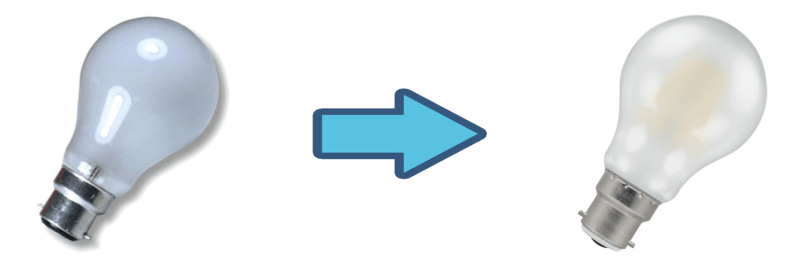
Incandescent Pearl GLS 60W replaced by LED Pearl GLS 7.5W
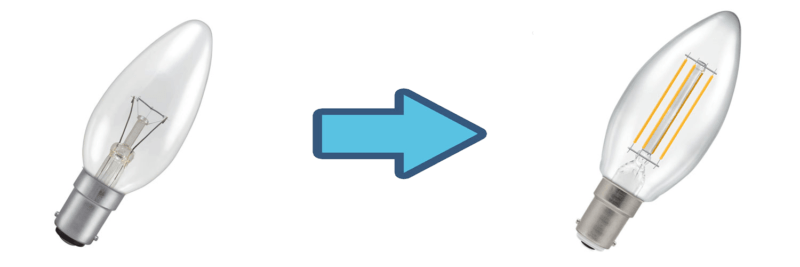
Incandescent Clear Candle 40W replaced by LED Clear Candle 5W
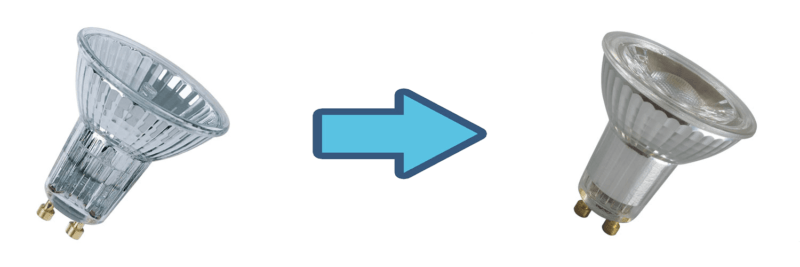
Halogen GU10 Spotlight 50W replaced by LED GU10 Spotlight 6W
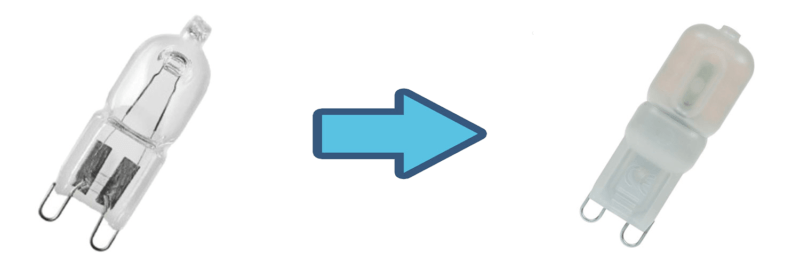
Halogen G9 Capsule 25W replaced by LED G9 Capsule 2.5W
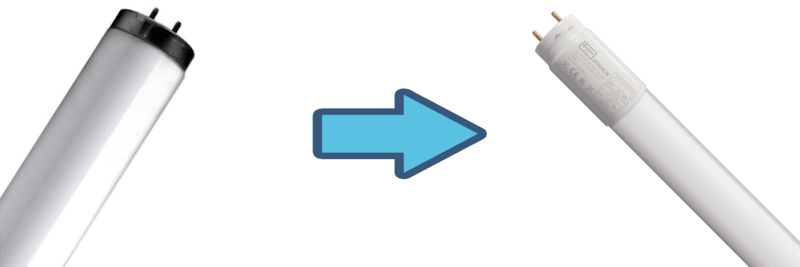
Fluorescent T8 5ft 56W replaced by LED T8 Tube 5ft 24W
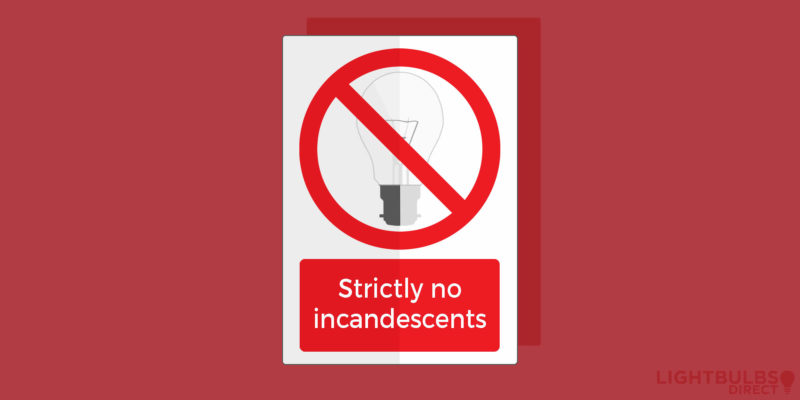




Over the past two years we have replaced all 38 of our old light bulbs with Chinese LED lamps, purchased from various UK suppliers. Result (with replacements) – none of them lasted more than a hundred hours. The minimum
quotedLED lifespan we can find today is 10,000 hours. In disgust; we’re reverting to theoldstandard GLS tungsten filament lamps.I hate LED lighting! We have had fluorescent lighting since 1938/9, why now are government’s wanting to ban this tried and trusted technology? With the likes of Philips low mercury fluorescent tubes which i use, i cant see the mercury being such a big problem. All the LED lighting i have ever used always results in the drivers failing prematurely. I’ve stockpiled fluorescent tubes and fittings and i wont be using LED.
I agree. Arrogant undemocratic power hungry eu!!
Candles were the best. I blame Thomas Edison and the Romans with their fancy oil lamps.
There are very good incandescent lights. Don’t try to be funny. It would be ignorant.